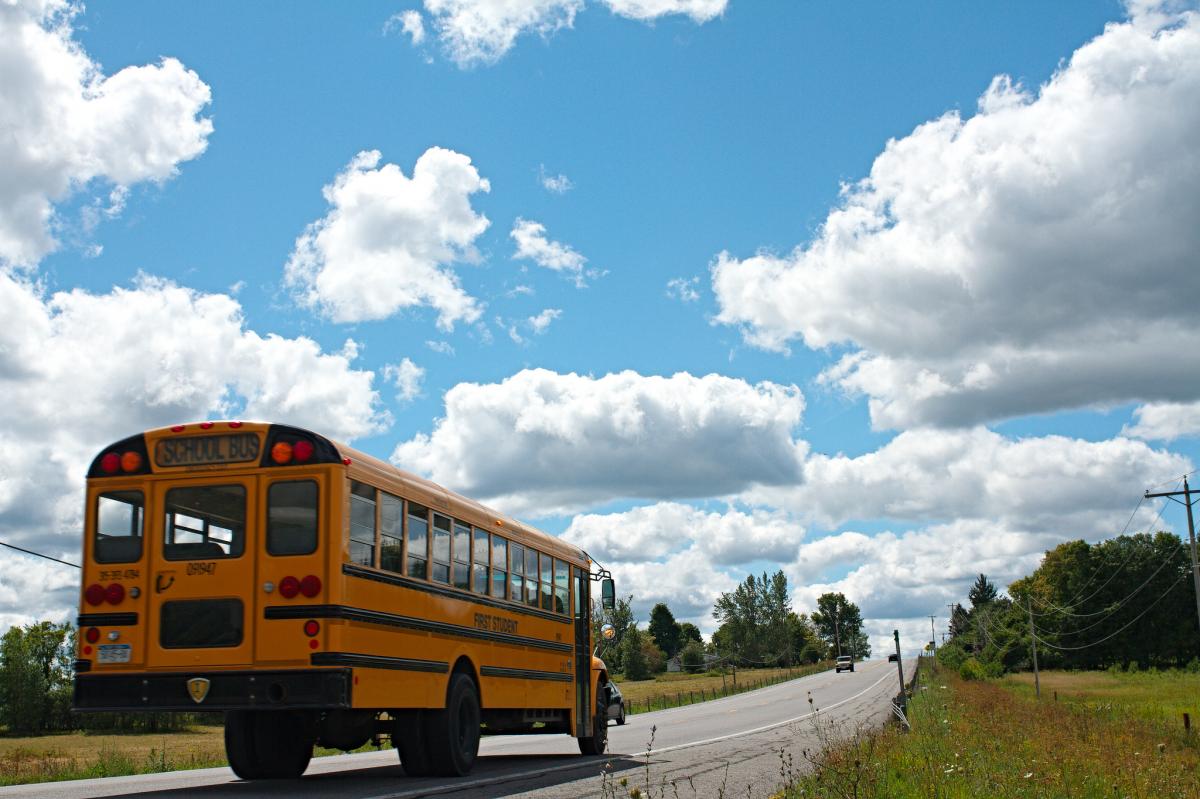Providing student meal distribution
An immediate priority for most districts has been ensuring students have access to adequate nutrition, especially at a time when many families have been impacted by coronavirus-related furloughs and record unemployment. For rural districts, however, families may not be able to make a daily trip to their schools to pick up meals.
In Fall River Joint Unified School district, which serves 1,200 K-12 students over 1,200 square miles in Shasta County, some students live up to 90 minutes away from their campuses. Many families that reside in these outlying areas cannot afford gas to travel regularly to pick up meals. The district now relies on its bus drivers to deliver meals and schoolwork directly to geographically isolated families. Centrally located families can still pick up their meals from school sites.
Delivering technology and instruction
Remote locations and high-poverty levels in many rural communities not only make food distribution challenging, but, for many rural schools, they also make “virtual learning” especially difficult. An EdSource analysis found that while 78 percent of urban households subscribe to internet services, only about one-third of rural households do.
Fall River Joint Unified and other districts are working to identify areas and families without reliable access and are setting up WiFi hotspots throughout vulnerable areas. Due to inequitable access to technology, Fall River Joint Unified is distributing packets of schoolwork for students for now, with local partner Mayers Memorial Hospital paying to mail packets to the homes of some students. The district, like many, is working to improve digital resources for all its students.
Superintendent Jeff Roberts of Plumas Lake Elementary School District said officials have taken multiple steps to identify gaps in digital access for district families. Most families residing in developed areas have internet access and devices, but the district also serves a sizable rural population. Even when those students and their families have WiFi, slow internet speeds make video-related communications and lessons untenable for continued distance learning. The Yuba County district began identifying the issue by sending an electronic survey to families on several platforms, asking them to identify their access to devices and WiFi. Next, classified staff made phone calls to each family that did not respond to the survey, ultimately resulting in a 97-percent response rate, which has helped staff target specific areas and needs.
Plumas Lake ESD staff have now distributed hundreds of Chromebooks and are planning to deploy mobile hotspots in areas with known gaps. Given the increased demand, however, the district is competing with others for technology, and devices like mobile hotspots are on backorder with most vendors. Families with one or two children receive a single device, and those with three or more enrolled children receive two. The administration is planning a follow-up survey to ensure that the system is working after the rollout and to identify the instructional materials (e.g., crayons, pencils, paper) that families need to complete their assignments.
Roberts cautions educators and families to be realistic with their expectations. “It’s important to remember that we’re not ‘homeschooling’ or even ‘distance learning.’ This is what I’m calling ‘emergency learning,’” he said. “It’s not like we launched this initiative after developing a huge, thought-out plan. It’s a crisis, and we’re shifting so we can meet our students’ needs in this context. It won’t be perfect. We’re all just doing our best.”
Meeting special education needs
Throughout the nation, schools are working to identify strategies to ensure students with disabilities have access to a Free Appropriate Public Education (FAPE). At the moment, Fall Rivers Joint USD considers its curriculum packets “enrichment,” but once it shifts to more formal instruction on April 20, it plans to draw more upon its paraprofessionals for support, particularly with students who have Individualized Education Programs and 504s.
In Plumas Lake ESD, Roberts continues to work with his team to flesh out plans for supporting students with disabilities. For now, their plan includes providing general education instruction in Zoom video conferences, with paraprofessionals providing additional supports in small group Zoom breakout rooms or in separate follow-up Zoom sessions. He anticipates that some students will also receive support by phone. Speech therapists have already shifted to online sessions, a practice that the district’s occupational therapist contractors will soon begin.
As with all California districts, these leaders emphasized their plans continue to evolve with guidance from both the state and U.S. Department of Education.
Keeping up with rapidly changing guidance
Rural districts naturally have a smaller central office with a small number of administrators responsible for tracking rapidly evolving guidance from federal, state and county agencies, not to mention educational organizations and associations. “It’s one of the hardest pieces to keep on top of; there’s just too much information and the guidance is constantly changing,” said Roberts. “I try to go directly to the source for my information as much as possible: Governor Newsom. Superintendent Thurmond. The California Department of Education. My county office of education is sending lots of information, too.”
Fall River Joint USD Superintendent Merrill Grant also credits the Shasta County Office of Education with sharing information that reflects their local context. “Most of the media is focused on the national level, so it helps that the county office is being proactive, providing us updates for our local region. And the CDE has really stepped up quickly.”
According to Roberts, however, being a smaller district also has its benefits. While larger districts have more district office staff to provide explicit direction to teachers, administrators, and classified personnel, he argues, “We’re small enough to adapt more rapidly. We’re handing a lot of power to our teachers and saying, ‘We trust you.’”
Resources:
Meals-to-You Emergency Rural Delivery Program
Getting Internet Access: Telecom and Data Services Expanding Coverage





